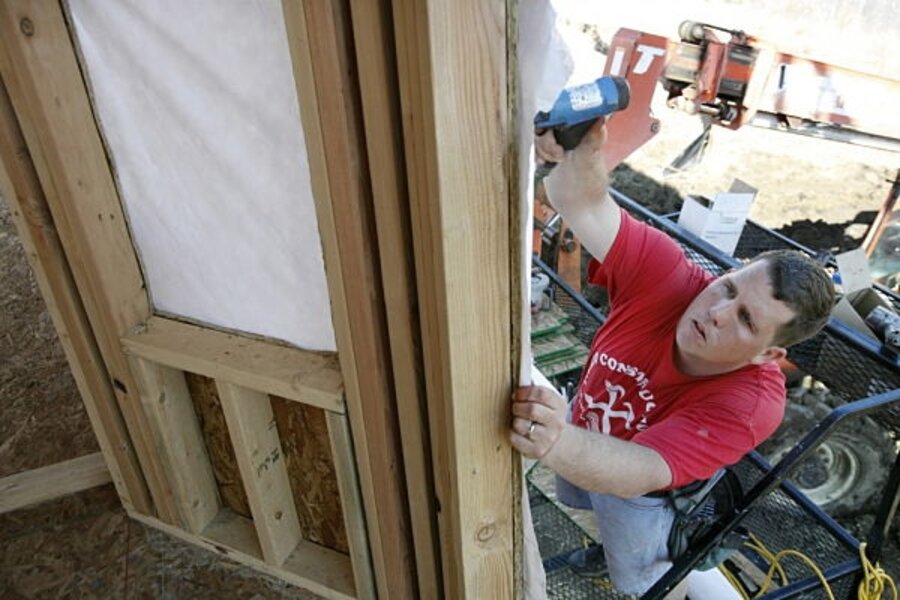Signs of easing in US economic slide
Loading...
| New York
The economy is still sinking, but some economists see a rate of decline that is less precipitous than before. If that’s the case, it could mean the longest recession in US history is beginning to bottom out.
A slower rate of decline is essential because production of goods and services has been in a steep dive since last fall. Although any lessening of the economic fall probably won’t affect the unemployment rate immediately, it could boost sagging consumer and business confidence and help the stock market, which is often a harbinger of economic improvement.
“We’re still declining, but we can see the valley down below,” says Sung Won Sohn, an economist at California State University, Channel Islands.
Some signs of a better economy include:
•The rate of decline of industrial production has been moderating since December. This is in large part because companies have finally reduced inventories to manageable levels.
•Prices are rising for some key commodities such as copper, which is used by the housing industry.
•Since last fall, the cost of shipping by oceangoing freighters has tripled – up from very low levels. That’s a sign of better global economic activity.
•Some surveys are finding that the consumer mood is brightening. This has translated into higher spending over the past three days.
•Construction of new housing rose 22.2 percent from January, the Commerce Department reported Tuesday. Such activity is still down 47.3 percent below a year earlier, but at least the trend line is in a positive direction, if it holds. (Which region did best? Click here.)
The Fed to meet
The developments preceded a Federal Reserve Board meeting this week, in which the economy and interest-rate policy will be discussed. The Fed has already lowered short-term rates to almost zero, so it is not expected to make any changes to interest-rate policy. Fed Chairman Ben Bernanke has said in recent weeks that the Fed will continue to use nonconventional ways to stimulate the economy.
“Obviously, there will be no change in interest rates, but we will be looking for any changes in wording on the economic outlook,” says Scott Brown, chief economist at Raymond James & Associates, a brokerage house, in St. Petersburg, Fla. “Will they say anything about whether they expect the economy to recover this year, as Mr. Bernanke said on ‘60 Minutes’ on Sunday, or in 2010?”
A sense that the worst of the downturn could be over is one reason the Dow Jones Industrial Average has shown some gains over the past week. The markets have also benefited from some improvement in the stock prices of banks. Last week, Citigroup and Bank of America executives said their firms have been profitable for the first two months of the year.
Banks are key
Profitable banks and a stable financial system are essential for the recovery to begin, Bernanke said Sunday on “60 Minutes.” “We’ve seen some progress in the financial markets, absolutely,” he said. “But until we get that stabilized and working normally, we’re not going to see recovery.”
If the financial system is stabilized, he added, “we’ll see the recession coming to an end probably this year.”
A key early indicator is industrial production, says Nariman Behravesh, chief economist at IHS/Global Insight in Lexington, Mass. In December, this monthly indicator dropped 2.4 percent, but the declines have been less severe since then: 1.9 percent in January and 1.4 percent in February.
“What’s been happening is that companies had fairly high inventories, then they slashed prices, and now inventories are at more manageable levels,” says Mr. Behravesh.
Now that inventories are lower, expectations are building for some improvement in the economy as companies start to rebuild depleted stockpiles. “We could get a pretty good rebound in industrial production,” Behravesh predicts.
Some key commodities, used in producing goods, are also starting to revive. Copper prices are up about 25 percent this year, bolstered in large part by buying from China, according to Bloomberg News. The news service says China has also taken advantage of low prices to stock up on aluminum, zinc, corn, and cotton.
“The recent stock market rally has sent speculators, betting the worst is over, back into copper, oil, and other commodities,” says Phil Flynn, director of research at Alaron Trading in Chicago. “There is an expectation of seeing demand come back a little bit.”
Consumers conflicted
Some surveys indicate that consumers see this is a good time to buy a car or a house. But “then they add, ‘This is a good time, but I’m so uncertain about my job and my income prospects, I have to put that on hold,’ ” says Richard Curtin, director of the Reuters/University of Michigan Surveys of Consumers in Ann Arbor, Mich. “Consumers are rethinking how long they should keep their cars, and that holding period is lengthening.”
Consumers’ mood, however, may be brightening somewhat. Over the past week, the Gallup’s Consumer Mood Index rose from -120 to -90.
“That’s an enormous change,” says Dennis Jacobe, Washington-based chief economist for the organization. “We’re now at the best level since last September.”
Improvement in the consumer mood is translating into higher spending, according to Gallup, which tracks spending (except for housing and autos) on a daily basis.
“Over the last three days, we’ve seen an increase in the spending index,” says Mr. Jacobe. “It takes a few days for the improvement in the mood index to have an impact on spending.”





